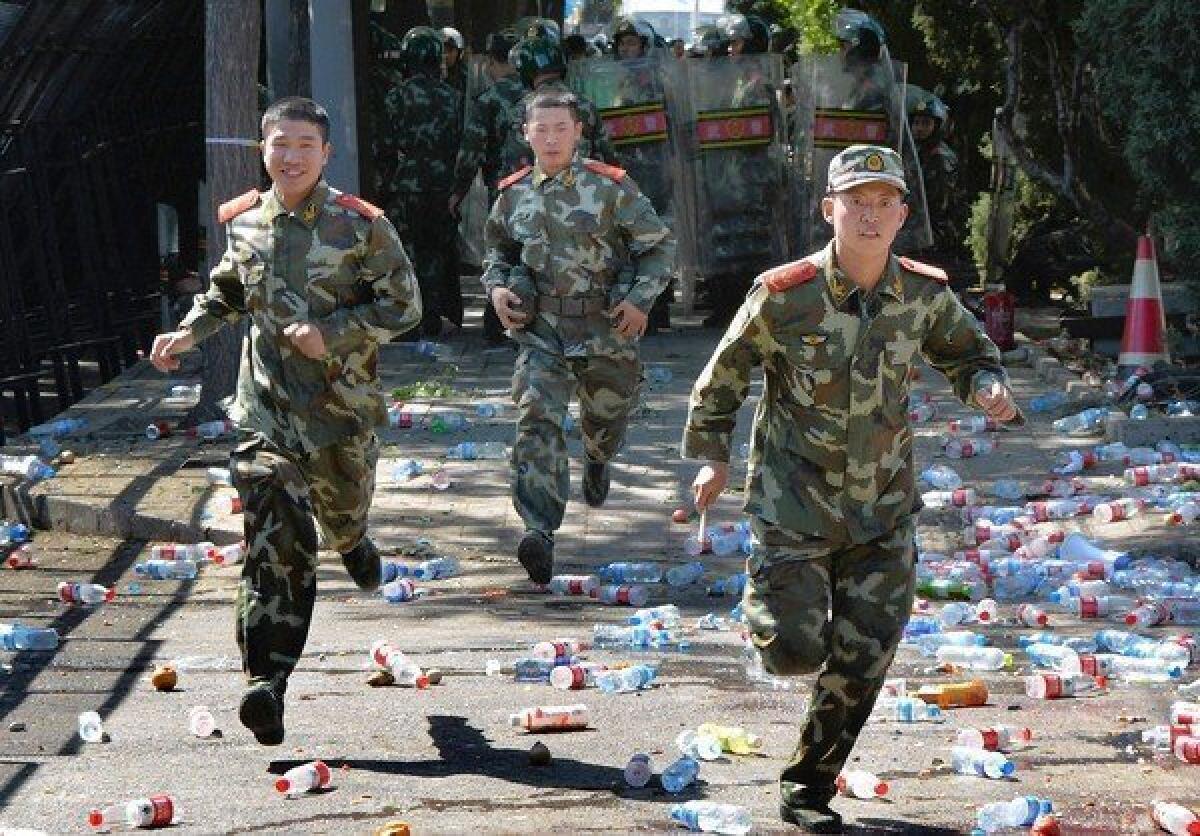China government’s hand seen in anti-Japan protests

BEIJING — The last week’s anti-Japan demonstrations in China have been a spectacular display of just how easily the ruling Communist Party can harness the power of protest.
In the aftermath of nationwide protests, in which mobs trashed Japanese-owned businesses and set fire to Japanese model cars, critics are questioning the degree to which the Chinese government fanned the flames as part of its dispute with Japan over an island chain both nations claim.
“It is obvious that this was planned,” said Ai Weiwei, the dissident artist, who videotaped some of the protests. The 1989 pro-democracy demonstrations in Tiananmen Square were “the last time that the people themselves organized a real protest and then the government sent in tanks to crush them,” he said.
Although there has been no evidence that police officers participated in the violence, in many cities they directed the public on where to protest and cleared streets to allow tens of thousands to mass. Many protesters interviewed Tuesday said they had been given the day off by employers to demonstrate. Sept. 18 is a traditional day of protest, marking the anniversary of the Japanese invasion of Manchuria in 1931.
“I need to lead the crowd and guide them to march in an orderly fashion,” wrote a police officer in Jiangxi province in a microblog posting that was later removed.
Han Deqiang, a prominent Maoist professor, wrote that he demonstrated Tuesday in Beijing with 500 to 600 farmers who had come from Hebei province, which raised the possibility that buses had been organized for the demonstrations. (“The farmer brothers were holding Chairman Mao’s portraits and they kept on chanting, ‘Down with the Japanese Imperialists!’” he wrote.)
“It is obviously there was a government hand in organizing this. How else could 500 farmers come from the provinces?” said Wen Yunchao, a prominent blogger from Guangzhou.
The protests evaporated by midweek. In Beijing, the subway station near the Japanese Embassy was closed Wednesday and buses were refused permission to stop on the main street nearby. Transportation was up and running again Thursday, but the area was deadly quiet, with police and paramilitary officers posted at every intersection. Security forces were so pervasive that even a hot dog vendor outside the subway stop wore a red armband showing he was a member of the volunteer patrol.
The official New China News Agency removed a slide show it had posted of the top 10 “anti-Japanese film” and ran editorials urging restraint.
“Irrational, violent anti-Japanese protests should be avoided,” editorialized the Global Times, a newspaper closely tied to the Communist Party.
James Reilly, a scholar who has written a book about Chinese public opinion toward Japan, said negative and positive stories planted in the state media are used to tell the public how to behave.
“The government is really good at sending signals about when it is OK to protest and when it is not,” Reilly said.
Anti-Japanese sentiment is no doubt genuine enough among Chinese, still angry about Japan’s brutal occupation before and during World War II. But political analysts believe the public venting of anger, in a country where protest is illegal, was unleashed to send a message to Japan about its plans to nationalize a string of disputed islands, known as Senkaku to the Japanese and Diaoyu to the Chinese. The Japanese government is buying three of the islands from a Japanese family.
In Tokyo, Chief Cabinet Secretary Osamu Fujimura told reporters Thursday that the Japanese government will ask China to pay for damages to diplomatic missions caused by protesters, but it did not specify an amount.
At the height of the violence, dozens of Japanese businesses were attacked, including a Panasonic plant in Qingdao, a Toyota dealership and 7-Eleven shops. Hundreds of Japanese model cars were overturned or burned.
At one point Tuesday, protesters at the Japanese Embassy in Beijing swarmed to the nearby U.S. Embassy and threw bottles at a car carrying Ambassador Gary Locke. The embassy said there was no danger to Locke or serious damage or danger to the mission.
Eventually Chinese officials appeared to have become unnerved by the extent of the violence, coming in the midst of an already chaotic political transition. Many protesters carried portraits of Mao Tse-tung and some chanted in support of Bo Xilai, the purged Communist Party chairman of Chongqing, whose wife was recently convicted of murder. Bo was considered a rival of Vice President Xi Jinping, who is to be named China’s next leader at a coming Communist Party congress.
“Diaoyu island belongs to China; Bo Xilai belongs to the people,” read one banner protesters were carrying in Chengdu.
In Beijing, a small scuffle broke out between protesters when Han, the left-wing professor, slapped an older man who witnesses said had disparaged the Mao slogans.
“There are a lot of political risks to the government in allowing these kinds of anti-Japan protests. Not only were there pro-democracy demands, you had extreme leftists out demonstrating and those people are even more dangerous to the current government,” said Wen, the blogger.
With the Chinese government clamping down, Japanese businesses have started to reopen. At a popular Japanese restaurant in Beijing, which flew a Chinese flag outside to show it was not Japanese-owned, the head sushi chef said business was about one-third of normal.
“I’m still nervous. I have friends calling telling me I’m a traitor to be working here,” said the chef, Bruce Yan. Yan, a Chinese citizen who trained in Japan, said he politely disagreed with his friends. “I love my country too, but rationally.”
More to Read
Start your day right
Sign up for Essential California for news, features and recommendations from the L.A. Times and beyond in your inbox six days a week.
You may occasionally receive promotional content from the Los Angeles Times.







